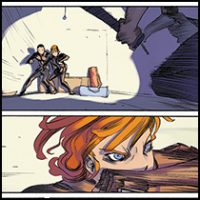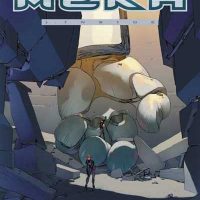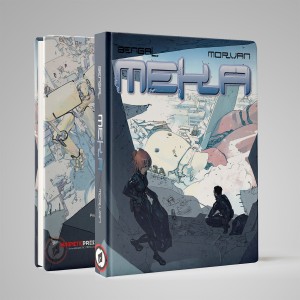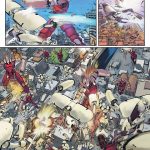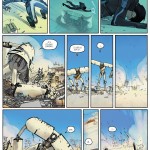MEKA is a unique take on what appears on the surface to be a familiar sci-fi genre – the giant robot, made popular in Japanese Manga and Anime. What were the inspirations for the idea and look of this particular story?
J.D. Morvan: Hmm, all this comes from cartoons that we watched as kids. We did not have to Mazinger Z in France, but Grendizer (or “Goldorak” for us). We grew up along with the generations of the whole world bathed a flood of huge robots. The Japanese release of Evangelion, led us in our corner to develop our own way of thinking about huge robots. I noticed that during the fights in town, we did not see human beings dying. It is funny to destroy buildings and to walk through the streets, but we forgot about those who lived there. Meka speaks about them. And also a little about the pilots of the bombers in the Second World War, who bombarded allied territories (such as France), but not being able to see the damage they caused. Thus they fight with a lesser awareness of their acts. Meka mixes the lives of bombardiers and the bombarded.
Bengal: At the time when JD and I started talking about doing some BD together, I was still a concept designer in a French video game development studio, Darkworks, with my two good friends Nicolas ‘Sparth’ Bouvier & Benjamin ‘Ornicar’ Carré. At that time, I was working mostly on a futuristic project, and I was in charge of designing suits, weapons & mechs for the game in development. But month after month, as the game was getting closer to never being released, I was very frustrated not to be able to see my design work come to life… JD had this story he wanted to tell, about this never told relation between soldiers and victims during a war. The consequences at a human level. The pure affect. So, both to pay a tribute to the giant robot Japanese anime we love so much since Grendizer (the first anime I watched as a kid!) all the way to Evangelion (which, you can tell, somewhat inspired the other army’s design in Meka, i must admit), as well as to be able to release my designer’s frustration, we chose to tell this story in a war involving giant robots fighting.
The story takes a very different direction very early, in that the title vehicle is absent for much of the story after becoming disabled in the opening combat sequence. What made you want to constrain the focus away from the Meka itself, and how do you keep it a key element in the overall story?
JDM: In fact, we wanted to tell a part rarely put forward in these fights of robots, as I mentioned. The meeting of the “executioners” and the “victims”. Meka remains the central element, but it does not work any more. That is, I hope, the originality of this story. Also, whatever takes place before and after Meka, everybody has already read it 100 times. It was useless to explain it, each can imagine that part at his/her convenience.
B: As hinted above, we could have told this same story in many different eras, with about any fictional or even existing war we could think of, really. In any, war, we could tell about soldiers having to deal with their deeds, their victims, their culpability. That’s one of the reasons why we leave the robots behind early – it is not about them, simply!
The scenario is very sci-fi, set in a far future where mankind has colonized the far reaches of space, yet the themes of warfare morality are very familiar. What similarities do you see to modern technology, and what differences?
JDM: Meka it is science fiction, but as any good science fiction (at least the sort that I love), it approaches contemporary themes. The main thing here is this paradox: it seems normal for armies to kill 10 people to save 1000 from the enemy, and the soldiers are trained for that. But what happens when they meet the families of 10 people that they killed “for their own benefit”?
Of course, both pilots have different opinions on the question, which allows us to develop a reflection from several angles… And to place the reader in front of this reality, to put him in front of a matter of conscience.
B: The common factor in any case is the human being. That’s the essence here. Unless you tell a story about machines, AIs fighting by themselves, you have to deal with the human mind. As JD said, what happens before and after the story in Meka, it’s been seen hundreds of times. Conflict, opposing armies, and then later on resolution and redemption of some kind… We wanted to only depict what happens in the middle, as it’s rarely shown from this perspective, I feel. So, although I would love to tell SF stories where mech design in itself is key to the plot and how events can unfold, I appreciated that it was not the case in Meka!
The story ends on an open-ended note. Do you have future stories in mind for the characters or for this universe?
JDM: No. But I have to admit that sometimes, to tell the battle against the pirates and the pilots’ return to their base still titillates me.
B: We could go anywhere with that, I believe. We never intended to, we think about it sometimes, but it’s not necessary, it’s not mandatory. Who knows? JD would like to tell the followup, I believe, and I’d like to tell the adventures of other characters from the same army rather – or the opposing one, why not! Many things are possible.
This title represents one of the first, early collaborations between the two of you. How do you feel your work has changed since this project?
JDM: Yes of course. While making Meka I realized that to make a BD with a “classic” story (even if this story is not that) was a little bit overwhelming for Bengal who is also a great illustrator. We thus said to ourselves that in our following BD (Naja), we would use a little fewer panels, and try not to give the reader an experience that is too fast to read, we added texts off narrative. In brief, Naja arose from Meka.
B: It was our first solid work together I’d say, indeed, but we know each other since a much longer time and we were in tune already when we worked on Meka. Everything done after was done on the same balance between us – except for the fact that I learned much in Meka, then in Naja, and it allowed me to progress in the way I can use illustration skills for comic panels… and how to make my storytelling more efficient for people to read.




